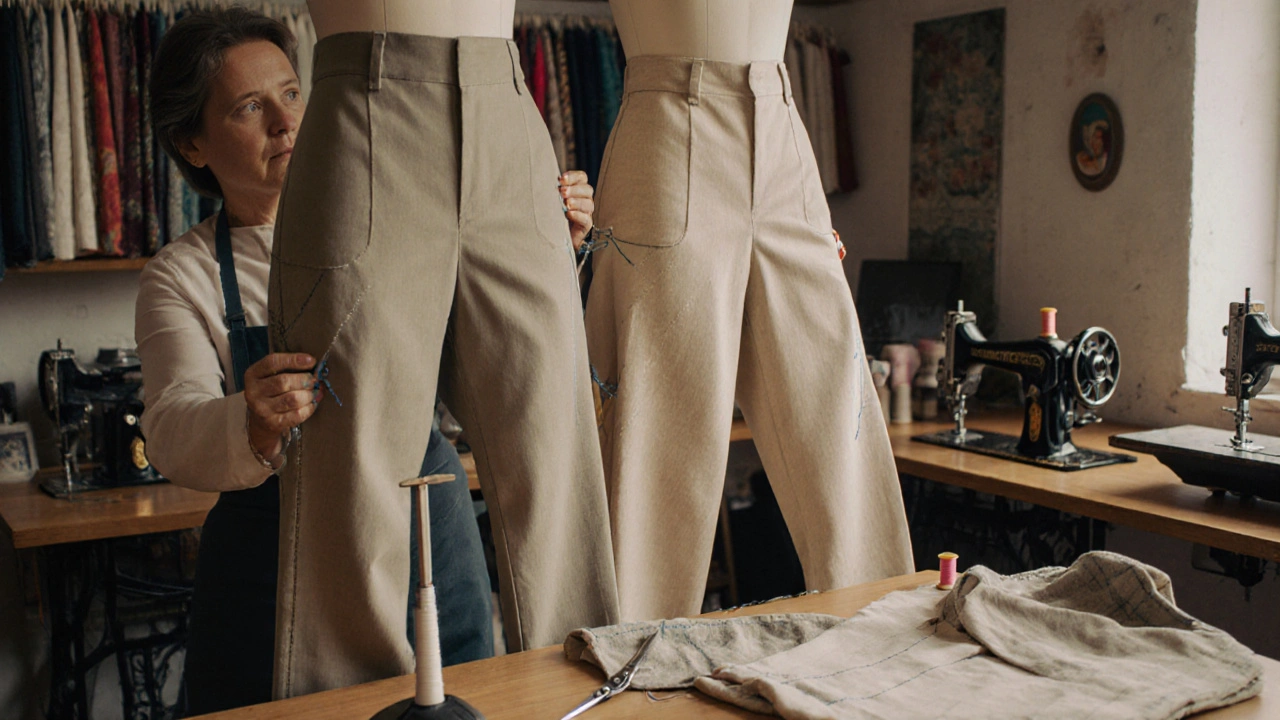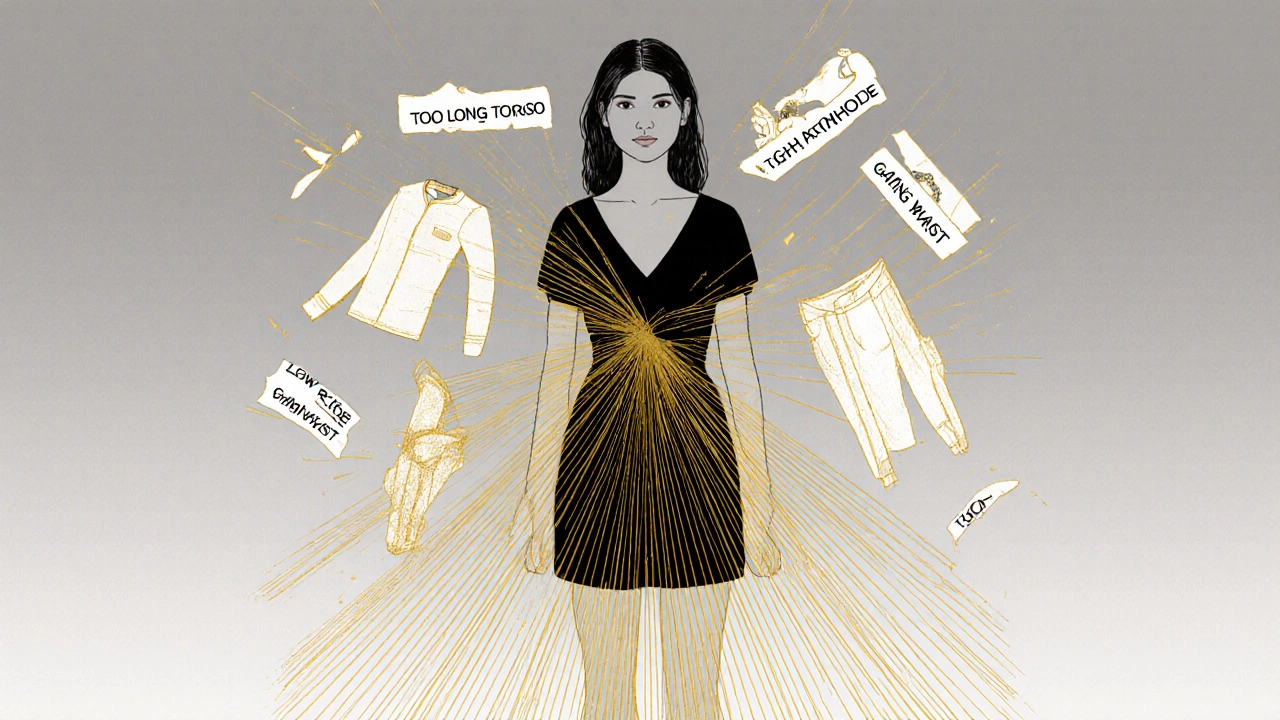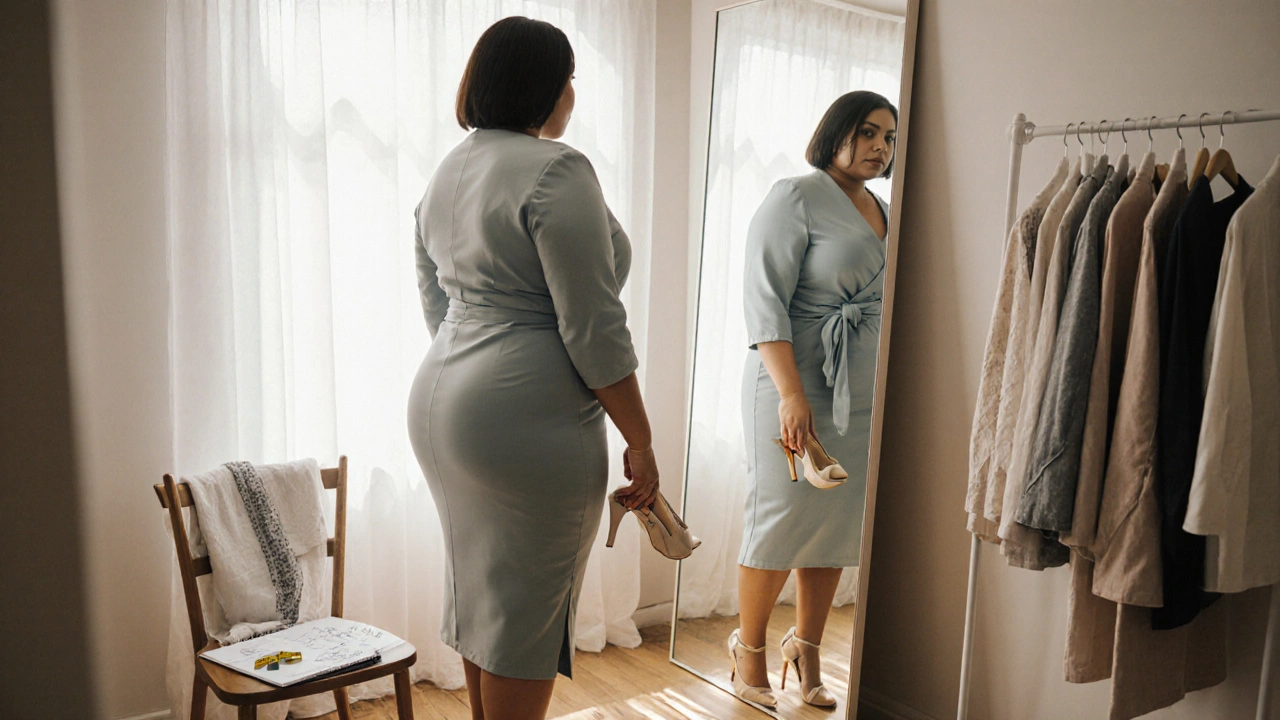Too many plus-size women know the feeling: you find a dress you love, try it on, and it’s almost perfect-except the shoulders dig in, the waist gapes, or the hem pools awkwardly around your ankles. You leave the store frustrated, convinced the problem is your body. But here’s the truth: it’s not your shape. It’s the pattern.
Most ready-to-wear clothing, even from brands that claim to be inclusive, is designed using the same base pattern scaled up. That doesn’t work. A size 18 isn’t just a size 8 with extra fabric. Your curves, your posture, your bone structure-they’re different. And that’s why off-the-rack clothes often look like they were made for someone else. Tailoring isn’t a luxury for plus-size bodies. It’s a necessity for comfort, confidence, and style that actually fits.
Why Standard Patterns Don’t Work for Curvy Figures
Think of a dress pattern like a blueprint. When a designer scales a size 6 up to a size 20, they don’t rebuild the blueprint-they stretch it. That means the bust gets wider, the hips get wider, but the slope of the back, the curve of the waist, the length from shoulder to hip-all stay proportioned for a smaller frame. The result? A garment that’s too long in the torso, too tight across the shoulders, and too loose in the wrong places.
Plus-size bodies often have different proportions: wider hips relative to waist, fuller busts, stronger upper back curves, or more丰满的臀部与大腿连接处. Ready-made clothes ignore these details. A size 20 might have the same armhole depth as a size 12. That’s why sleeves feel tight even when the rest of the shirt is baggy. That’s why the waistband of pants rides up in the back. It’s not you. It’s the math.
Studies from the Fashion Institute of Technology show that 78% of plus-size women report dissatisfaction with the fit of off-the-rack clothing. Only 12% say they’ve found a brand that consistently fits without alterations. The gap isn’t about size-it’s about design philosophy.
What Tailoring Can Actually Fix
Professional tailoring doesn’t mean turning a dress into something completely different. It means making smart, subtle adjustments that honor the original design while adapting it to your body. Here’s what’s possible:
- Waist nipping: If the waistband gapes or the fabric bunches, a seamstress can take in the side seams or add darts to follow your natural curve. This creates structure without squeezing.
- Hem adjustments: Many plus-size garments are cut too long because they’re scaled from petite or straight-size patterns. Shortening the hem by just 1.5 inches can make a dress look intentional, not sloppy.
- Shoulder and sleeve width: If the shoulders look like they’re hanging off your frame, or the sleeves are tight under the arms, the armhole can be reshaped and the sleeve cap adjusted. This is one of the most common fixes-and one most people don’t realize is possible.
- Bust darts: If the fabric pulls across the chest or gaps at the top of the bust, adding or deepening darts can create a smooth, flattering shape without adding bulk.
- Pants rise and thigh fit: Many plus-size pants have low rises that dig into the stomach. Raising the rise and adding ease through the thigh and hip area eliminates bulging and creates a clean line from waist to ankle.
These aren’t minor tweaks. They’re the difference between feeling like you’re wearing a costume and feeling like you’re wearing something made for you.
How to Find a Tailor Who Gets Plus-Size Bodies
Not every tailor is trained in plus-size alterations. Some assume bigger means just adding fabric. Others have never worked with a body that has a 40-inch bust and a 34-inch waist. You need someone who understands curves, not just sizes.
Here’s how to find the right one:
- Ask for experience: Don’t be shy. Call or email and ask, “Do you regularly work with plus-size clients? Can you show me examples of alterations you’ve done on fuller figures?”
- Look for local recommendations: Facebook groups for plus-size fashion in your city, Instagram hashtags like #plus sizetailoring or #curvyseamstress, and local boutiques that carry extended sizes often have trusted tailors they refer.
- Check portfolios: A good tailor will have before-and-after photos. Look for examples where the garment was clearly not designed for a curvy body but now fits like it was made for it.
- Trust your gut: If they seem dismissive, say things like “Oh, that’s just how it is for larger sizes,” walk away. You deserve someone who sees your body as a challenge to solve, not a limitation to work around.
In New York, places like Alterations NYC and Curvy Couture Tailors specialize in plus-size fittings. But you don’t need a big city. Many small-town seamstresses have decades of experience and charge half the price of chain stores.

What to Bring to Your Alteration Appointment
Don’t just show up with the garment. Bring these three things:
- Your shoes: The height of your heel changes how a hem falls. If you wear flats most days, bring them. If you wear heels to work, bring those too.
- Your undergarments: The shape of your bra or shapewear affects how the garment drapes. Wear what you plan to wear with the outfit.
- A mirror: If you’re doing a fitting at home or a small shop, bring a full-length mirror. Seeing the garment from all angles helps you spot problems the tailor might miss.
Also, be ready to describe how you want to feel. “I want to look polished but not boxed in.” “I need to be able to sit comfortably at my desk.” “I want to feel like I’m wearing something expensive, not just something that fits.” Specific language helps your tailor understand your goal.
Costs and Time: What to Expect
Alterations aren’t cheap, but they’re worth it. Here’s a realistic breakdown for common fixes:
| Alteration | Cost Range | Time Required |
|---|---|---|
| Waist take-in (pants or dress) | $25-$50 | 1-2 days |
| Hem adjustment (dress or pants) | $20-$40 | 1 day |
| Shoulder and sleeve reshaping | $60-$100 | 3-5 days |
| Bust darts added | $35-$70 | 2-3 days |
| Full pants re-fit (rise, thigh, seat) | $80-$150 | 5-7 days |
Some tailors charge by the hour ($40-$75/hour), so ask for a flat rate upfront. Avoid places that quote “$10-$20 per stitch”-that’s a red flag. A good tailor will assess the garment and give you a clear price before starting.
Most alterations take 3-7 days. Rush jobs are possible, but they cost 50% more. Plan ahead, especially if you’re tailoring for a wedding, job interview, or vacation.

When Not to Alter-and What to Do Instead
Not every garment is worth altering. Here’s when to walk away:
- Too much fabric is missing: If the garment is already stretched to its limit and you need to add material, it’s better to return it or repurpose the fabric.
- Low-quality material: Cheap polyester that wrinkles, stretches out, or pills won’t improve with tailoring. You’re paying to fix a bad investment.
- Awkward design choices: If the neckline is too low, the sleeves are puffy and unflattering, or the color clashes with your skin tone, no amount of stitching will fix it.
In those cases, consider shopping differently. Look for brands that design for curvy bodies from the start-like Universal Standard, Good American, or Torrid’s premium line. These brands use multiple pattern blocks, not just scaled versions. They know the difference between a size 18 and a size 24. And they often offer free alterations within 30 days.
How Tailoring Builds Confidence
Fit isn’t just about appearance. It’s about presence. When your clothes move with you-not against you-you stand taller. You reach for things without worrying about a seam popping. You sit down without adjusting your skirt. You smile more because you’re not thinking about your clothes.
One client, a 52-year-old teacher, told me she hadn’t worn a dress to school in 15 years because nothing fit right. After three alterations on a simple wrap dress, she wore it to her daughter’s graduation. She cried when she walked in. Not because it was expensive. Not because it was trendy. Because for the first time in years, she felt like herself.
Tailoring isn’t about fixing your body. It’s about fixing the world’s assumption that your body is a problem to be hidden. It’s about reclaiming your right to wear what you love, exactly how you want to wear it.
Start Small. Build Your Alteration Toolkit
You don’t need to overhaul your whole closet at once. Start with one item you love but don’t wear because it doesn’t fit. A blazer. A pair of jeans. A dress you bought on sale and never returned.
Once you’ve had one piece altered, you’ll see the difference. You’ll notice how your other clothes could be better. You’ll start spotting pieces in stores that just need a little help. You’ll stop feeling like you’re shopping for “plus-size” and start shopping for clothes that fit your body-no labels needed.
That’s the real win. Not a perfect hem. Not a perfectly nipped waist. But the quiet confidence that comes from knowing your clothes work for you-not the other way around.
Can I alter plus-size clothes myself?
Yes, but only for simple fixes like hemming pants or taking in side seams. Complex adjustments-like reshaping armholes, adding bust darts, or altering the rise of pants-require experience and specialized tools. If you’re new to sewing, start with a basic kit and practice on old clothes. For anything that affects fit in key areas, a professional tailor will save you time, money, and frustration.
How often should I get my clothes altered?
If your body shape stays consistent, you only need to alter clothes once-when you buy them. But if you gain or lose weight, even a few pounds, you may need to revisit alterations. A 5-pound change can affect how pants sit on your hips or how a dress drapes across your bust. Keep your tailor’s contact info handy. Many offer free minor adjustments within 6 months of the original work.
Are tailors expensive for plus-size clients?
No, tailors don’t charge more because you’re plus-size. They charge based on complexity and time. A full pants re-fit takes longer than a simple hem, so it costs more. But the price isn’t tied to your size. If a tailor charges extra because of your body, find someone else. Legitimate tailors base pricing on the work, not the person.
What’s the best fabric for easier tailoring?
Wool blends, cotton twill, and medium-weight knits are the easiest to work with. They hold their shape, take stitches well, and don’t slip or stretch unpredictably. Avoid very thin, slippery fabrics like rayon or satin unless you’re working with a specialist. Thick, stiff fabrics like denim or canvas are doable but require heavy-duty machines and experience.
Can I alter clothes bought online?
Absolutely. Many online brands encourage it. In fact, some offer free return shipping if you get alterations done locally and send back the receipt. Always check the return policy first. If the item is final sale, make sure you’re comfortable with the fit before cutting. Try the garment on over your usual undergarments and take note of where it pulls, gaps, or bunches. Take photos and show them to your tailor.
When you invest in tailoring, you’re not just spending money-you’re investing in your daily comfort, your self-image, and your right to wear what you love without apology. The right fit doesn’t hide your body. It celebrates it.


Write a comment